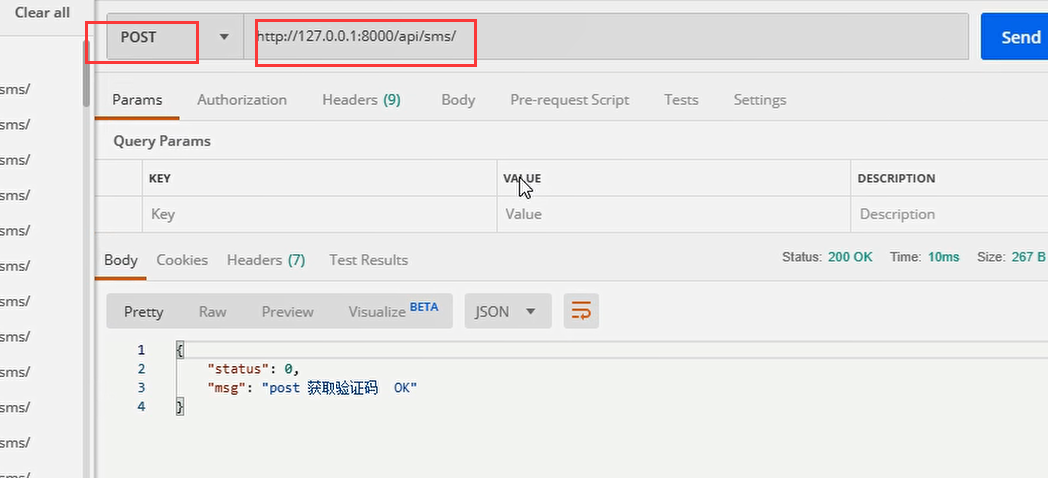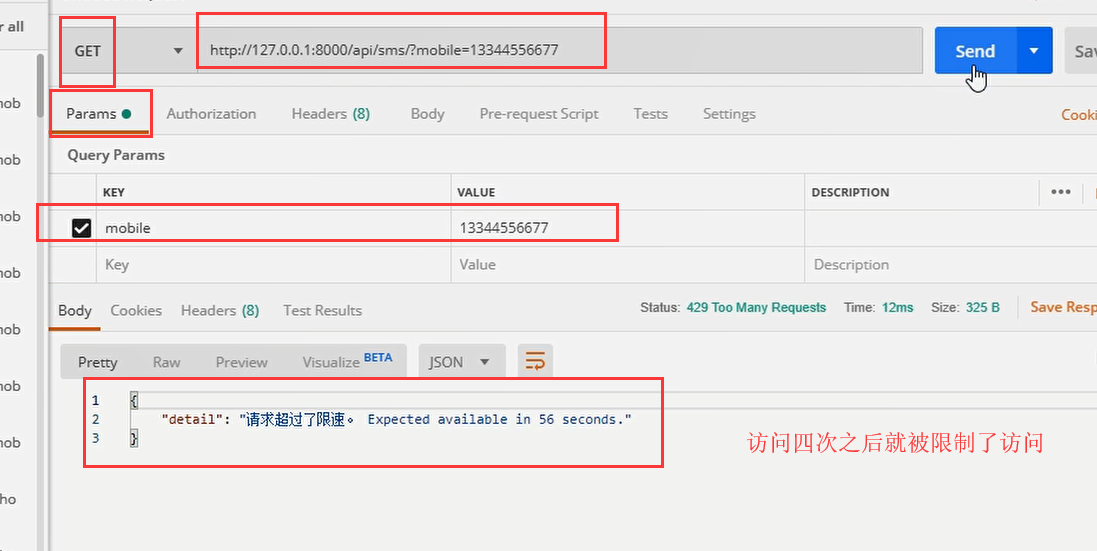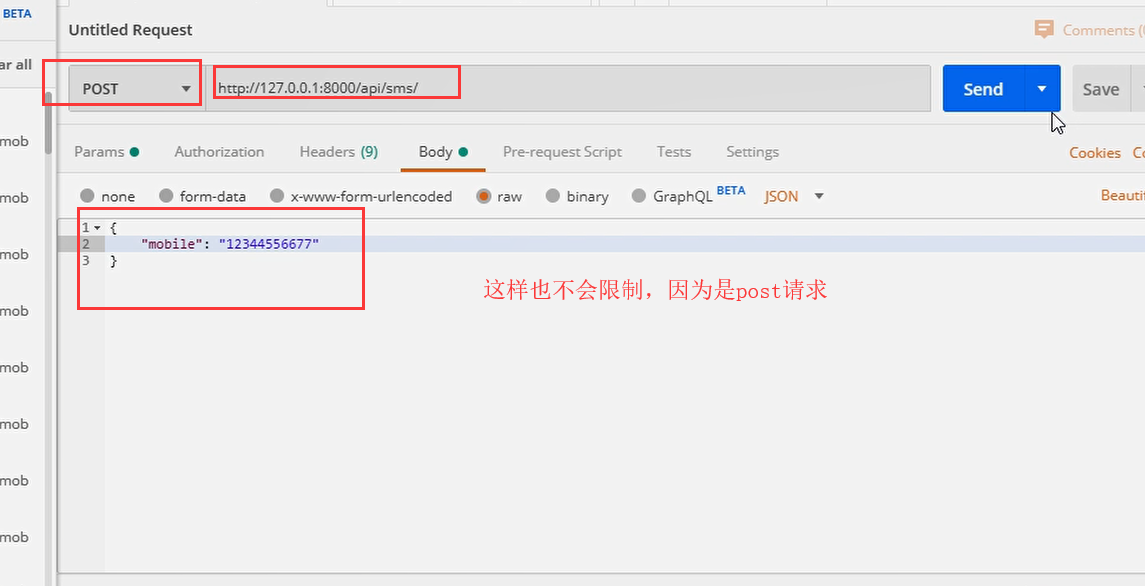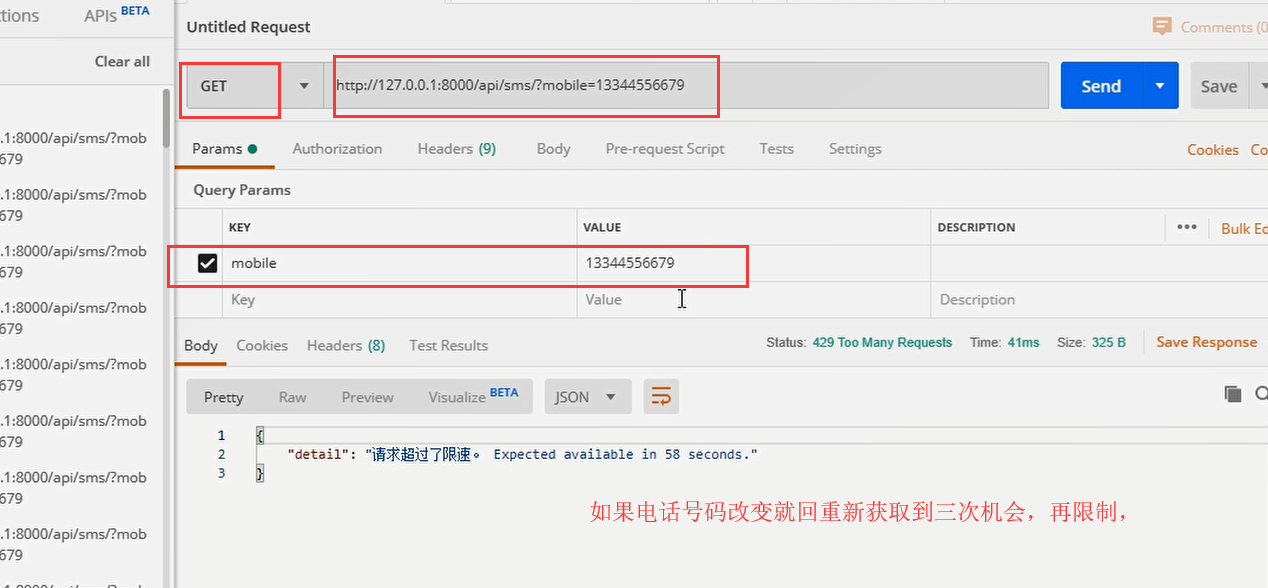drf的频率认证
频率认证源码分析
APIView ---》dispatch方法---》self.initial(request, *args, **kwargs)---》 self.check_throttles(request)
#重新访问这个接口的时候,都会重新调用这个方法,每次访问都会throtttle_durations=[]置空
def check_throttles(self, request):
"""
Check if request should be throttled.
Raises an appropriate exception if the request is throttled.
"""
#比如一分钟只能访问三次,第一,二,三次访问的时候都没有限制,第四次访问就会制
#限次的持续时间,还有多少秒才能接着访问这个接口
throtttle_durations=[]
# self.get_throttles()全局或局部配置的类
for throttle in self.get_throttles():
#allow_request允许请求返回True,不允许就返回False,为false时成立,
if not throttle.allow_request(request, self):
#throttle.wait()等待的限次持续时间
self.throttled(request, throttle.wait())
# 第四次限制,有限制持续时间才会走这部
if throttle_durations:
durations = [
duration for duration in throttle_durations
if duration is not None
]
duration = max(durations, default=None)
self.throttled(request, duration)
这说明我们自定义类要重写allow_request(request, self)和wait(),因为throttle调用了
点击 self.get_throttles()查看
def get_throttles(self):
"""
Instantiates and returns the list of throttles that this view uses.
"""
return [throttle() for throttle in self.throttle_classes]
点击 self.throttle_classes
throttle_classes = api_settings.DEFAULT_THROTTLE_CLASSES
throttle_classes跟之前一样可局部配置throttle_classes=[] ,可全局配置settings文件中配置
到drf资源文件settings.py文件中的APISettings类中查看默认配置:ctrl+f键查找DEFAULT_THROTTLE_CLASSES
'DEFAULT_THROTTLE_CLASSES': [],#所以说任何接口都可以无限次访问
回到def check_throttles(self, request):pass 中的allow_request方法进行思考,首先去获取下多长时间能够访问多少次,然后就是访问一次就计数一次,超次了就不能访问了,所以要去获取时间,在一定的时间内不能超次,如果在一定的时间内超次了就调用wait,倒计时多久才能再次访问,
allow_request其实就是先获取到多长时间访问多少次,每来一次请求把当前的时间和次数保存着,如果它两的间隔时间足够大,就重置次数为0,如果间隔时间较小就次数累加
找到drf资源文件throttling.py (有以下类)
AnonRateThrottle(SimpleRateThrottle)
BaseThrottle(object)
ScopedRateThrottle(SimpleRateThrottle)
SimpleRateThrottle(BaseThrottle)
UserRateThrottle(SimpleRateThrottle)
我们自定义的类有可能继承BaseThrottle,或SimpleRateThrottle
class BaseThrottle(object):
"""
Rate throttling of requests.
"""
#判断是否限次:没有限次可以请求True,限次就不可以请求False
def allow_request(self, request, view):
"""
Return `True` if the request should be allowed, `False` otherwise.
"""
#如果继承 BaseThrottle,必须重写allow_request
raise NotImplementedError('.allow_request() must be overridden')
def get_ident(self, request):
"""
Identify the machine making the request by parsing HTTP_X_FORWARDED_FOR
if present and number of proxies is > 0. If not use all of
HTTP_X_FORWARDED_FOR if it is available, if not use REMOTE_ADDR.
"""
xff = request.META.get('HTTP_X_FORWARDED_FOR')
remote_addr = request.META.get('REMOTE_ADDR')
num_proxies = api_settings.NUM_PROXIES
if num_proxies is not None:
if num_proxies == 0 or xff is None:
return remote_addr
addrs = xff.split(',')
client_addr = addrs[-min(num_proxies, len(addrs))]
return client_addr.strip()
return ''.join(xff.split()) if xff else remote_addr
#限次后调用,还需等待多长时间才能再访问
def wait(self):
"""
Optionally, return a recommended number of seconds to wait before
the next request.
"""
return None #返回的是等待的时间秒数
返回到 def check_throttles(self, request):
throtttle_durations=[]
for throttle in self.get_throttles():
if not throttle.allow_request(request, self):
#wait()的返回值就是要等待的多少秒,把秒数添加到数组里面
self.throttled(request, throttle.wait())
#数组就是要等待的秒时间
if throttle_durations:
#格式化,展示还需要等待多少秒
durations = [
duration for duration in throttle_durations
if duration is not None
]
duration = max(durations, default=None)
self.throttled(request, duration)
分析def get_ident(self, request):pass
查看:
num_proxies = api_settings.NUM_PROXIES
到APISettings中ctrl+F查找NUM_PROXIES
'NUM_PROXIES'=None
返回到def get_ident(self, request):pass函数方法
NUM_PROXIES如果为空走:
return ''.join(xff.split()) if xff else remote_addr
查看 SimpleRateThrottle类,继承BaseThrottle,并没有写get_ident方法
但是写了allow_request,和wait
class SimpleRateThrottle(BaseThrottle):
"""
A simple cache implementation, that only requires `.get_cache_key()`
to be overridden.
The rate (requests / seconds) is set by a `rate` attribute on the View
class. The attribute is a string of the form 'number_of_requests/period'.
Period should be one of: ('s', 'sec', 'm', 'min', 'h', 'hour', 'd', 'day')
Previous request information used for throttling is stored in the cache.
"""
cache = default_cache
timer = time.time
cache_format = 'throttle_%(scope)s_%(ident)s'
scope = None
THROTTLE_RATES = api_settings.DEFAULT_THROTTLE_RATES
def __init__(self):
if not getattr(self, 'rate', None):
self.rate = self.get_rate()
self.num_requests, self.duration = self.parse_rate(self.rate)
def get_cache_key(self, request, view):
"""
Should return a unique cache-key which can be used for throttling.
Must be overridden.
May return `None` if the request should not be throttled.
"""
raise NotImplementedError('.get_cache_key() must be overridden')
def get_rate(self):
"""
Determine the string representation of the allowed request rate.
"""
if not getattr(self, 'scope', None):
msg = ("You must set either `.scope` or `.rate` for '%s' throttle" %
self.__class__.__name__)
raise ImproperlyConfigured(msg)
try:
return self.THROTTLE_RATES[self.scope]
except KeyError:
msg = "No default throttle rate set for '%s' scope" % self.scope
raise ImproperlyConfigured(msg)
def parse_rate(self, rate):
"""
Given the request rate string, return a two tuple of:
<allowed number of requests>, <period of time in seconds>
"""
if rate is None:
return (None, None)
num, period = rate.split('/')
num_requests = int(num)
duration = {'s': 1, 'm': 60, 'h': 3600, 'd': 86400}[period[0]]
return (num_requests, duration)
def allow_request(self, request, view):
"""
Implement the check to see if the request should be throttled.
On success calls `throttle_success`.
On failure calls `throttle_failure`.
"""
if self.rate is None:
return True
self.key = self.get_cache_key(request, view)
if self.key is None:
return True
self.history = self.cache.get(self.key, [])
self.now = self.timer()
# Drop any requests from the history which have now passed the
# throttle duration
while self.history and self.history[-1] <= self.now - self.duration:
self.history.pop()
if len(self.history) >= self.num_requests:
return self.throttle_failure()
return self.throttle_success()
def throttle_success(self):
"""
Inserts the current request's timestamp along with the key
into the cache.
"""
self.history.insert(0, self.now)
self.cache.set(self.key, self.history, self.duration)
return True
def throttle_failure(self):
"""
Called when a request to the API has failed due to throttling.
"""
return False
def wait(self):
"""
Returns the recommended next request time in seconds.
"""
if self.history:
remaining_duration = self.duration - (self.now - self.history[-1])
else:
remaining_duration = self.duration
available_requests = self.num_requests - len(self.history) + 1
if available_requests <= 0:
return None
return remaining_duration / float(available_requests)
分析SimpleRateThrottle中的__init__方法
因为返回到get_throttles(self): return[throttle() for throttle in self.throttle_classes]
throttle()对象加括号调用触发__init__方法
#初始化没有传入参数,所以没有'rate'参数
def __init__(self):
# 如果没有rate就调用get_rate()进行赋值
if not getattr(self, 'rate', None):
self.rate = self.get_rate()
#解析rate,用两个变量存起来
self.num_requests, self.duration = self.parse_rate(self.rate)
所有继承SimpleRateThrottle都会走__init__
返回到
def check_throttles(self, request):
throtttle_durations=[]
#throttle初始化成功之后
for throttle in self.get_throttles():
#初始化成功之后调用allow_request方法,也就是SimpleRateThrottle中的allow_request
if not throttle.allow_request(request, self):
self.throttled(request, throttle.wait())
分析SimpleRateThrottle中的allow_request方法
def allow_request(self, request, view):
"""
Implement the check to see if the request should be throttled.
On success calls `throttle_success`.
On failure calls `throttle_failure`.
"""
#rate没有值,就永远也不会限制访问
if self.rate is None:
return True
#如果有值往下走
#获取缓存的key赋值给self.key
self.key = self.get_cache_key(request, view)
if self.key is None:
return True
self.history = self.cache.get(self.key, [])
self.now = self.timer()
# Drop any requests from the history which have now passed the
# throttle duration
while self.history and self.history[-1] <= self.now - self.duration:
self.history.pop()
if len(self.history) >= self.num_requests:
#频率失败
return self.throttle_failure()
#频率成功
return self.throttle_success()
#频率失败,返回false,没有请求次数
def throttle_failure(self):
"""
Called when a request to the API has failed due to throttling.
"""
return False
#频率成功
def throttle_success(self):
"""
Inserts the current request's timestamp along with the key
into the cache.
"""
# history中加时间,再成功再加,而且是加在insert列表的第一个,history长度就会越来越大,所以history的长度就是访问了几次
self.history.insert(0, self.now)
self.cache.set(self.key, self.history, self.duration)
return True
#一直成功一直成功,然后就超次了,所以就会返回False,所以就调用wait()
返回到
def check_throttles(self, request):
throtttle_durations=[]
#throttle初始化成功之后
for throttle in self.get_throttles():
#初始化成功之后调用allow_request方法,也就是SimpleRateThrottle中的allow_request
if not throttle.allow_request(request, self):
self.throttled(request, throttle.wait())
找到drf资源文件throttling.py (有以下类)
以下是系统提供的三大频率认证类,可以局部或者全局配置
ScopedRateThrottle(SimpleRateThrottle)
SimpleRateThrottle(BaseThrottle)
UserRateThrottle(SimpleRateThrottle)
分析UserRateThrottle(SimpleRateThrottle)
class UserRateThrottle(SimpleRateThrottle):
"""
Limits the rate of API calls that may be made by a given user.
The user id will be used as a unique cache key if the user is
authenticated. For anonymous requests, the IP address of the request will
be used.
"""
scope = 'user'
#返回一个字符串
def get_cache_key(self, request, view):
#有用户并且是认证用户
if request.user.is_authenticated:
#获取到用户的id
ident = request.user.pk
else:
ident = self.get_ident(request)
#'throttle_%(user)s_%(request.user.pk)s'
return self.cache_format % {
'scope': self.scope,
'ident': ident
}
点击self.cache_format
cache_format = 'throttle_%(scope)s_%(ident)s'

假设我的认证类采用了UserRateThrottle(SimpleRetaThrottle),
for throttle in self.get_throttles():pass 产生的throttle的就是UserRateThrottle产生的对象,然后UserRateThrottle中没有__init__,所以走SimpleRetaThrottle的__init__方法
def __init__(self):
if not getattr(self, 'rate', None):
self.rate = self.get_rate()
self.num_requests, self.duration = self.parse_rate(self.rate)
点击self.get_rate(),
def get_rate(self):
"""
Determine the string representation of the allowed request rate.
"""
#如果没有scope直接抛异常,
#这里的self就是UserRateThrottle产生的对象,返回到UserRateThrottle获取到 scope = 'user'
if not getattr(self, 'scope', None):
msg = ("You must set either `.scope` or `.rate` for '%s' throttle" %
self.__class__.__name__)
raise ImproperlyConfigured(msg)
try:
#self.THROTTLE_RATES['user'] ,这种格式就可以判断THROTTLE_RATES是一个字典,点击进入THROTTLE_RATES = api_settings.DEFAULT_THROTTLE_RATES ,,跟之前一样资源settings.py中ctrl+F查找DEFAULT_THROTTLE_RATES,
# 'DEFAULT_THROTTLE_RATES': {
# 'user': None,
# 'anon': None,
# },
#然后在自己的settings.py中进行配置,就先走自己的配置,
#所以在这里的返回值是None
return self.THROTTLE_RATES[self.scope]
except KeyError:
# 当key没有对应的value的时候就会报错,而这里的user对应None所以是有value的
msg = "No default throttle rate set for '%s' scope" % self.scope
raise ImproperlyConfigured(msg)
返回到SimpleRetaThrottle
def __init__(self):
if not getattr(self, 'rate', None):
#self.rate=None
self.rate = self.get_rate()
self.num_requests, self.duration = self.parse_rate(self.rate)
点击 self.parse_rate(self.rate)
def parse_rate(self, rate):
"""
Given the request rate string, return a two tuple of:
<allowed number of requests>, <period of time in seconds>
"""
#如果rate是None,返回None,None
if rate is None:
return (None, None)
#如果rate不是None,就得到的是字符串并且包含有一个‘/’,因为拆分后得到得是两个结果,然后有int强转,所以num一定是一个数字
num, period = rate.split('/')
num_requests = int(num)
#period[0]取第一位,然后作为key到字典duration中查找,所以字母开头一定要是s /m / h / d,发现value都是以秒来计算,所以得到rate得格式是'3/min' 也就是'3/60'
duration = {'s': 1, 'm': 60, 'h': 3600, 'd': 86400}[period[0]]
return (num_requests, duration)
返回到SimpleRetaThrottle
def __init__(self):
if not getattr(self, 'rate', None):
#self.rate=None
self.rate = self.get_rate()
#self.num_requests, self.duration =None,None
self.num_requests, self.duration = self.parse_rate(self.rate)
为了能rate拿到值,就可以到自己得settings.py中配置
# drf配置
REST_FRAMEWORK = {
# 频率限制条件配置
'DEFAULT_THROTTLE_RATES': {
'user': '3/min',
'anon': None,
},
}
返回
def get_rate(self):
if not getattr(self, 'scope', None):
msg = ("You must set either `.scope` or `.rate` for '%s' throttle" %
self.__class__.__name__)
raise ImproperlyConfigured(msg)
try:
#return '3/min'
return self.THROTTLE_RATES[self.scope]
except KeyError:
msg = "No default throttle rate set for '%s' scope" % self.scope
raise ImproperlyConfigured(msg)
返回到SimpleRetaThrottle
def __init__(self):
if not getattr(self, 'rate', None):
self.rate = self.get_rate()
#self.num_requests:3, self.duration:60
self.num_requests, self.duration = self.parse_rate(self.rate)

返回到
def check_throttles(self, request):
throtttle_durations=[]
for throttle in self.get_throttles():
# 然后调用allow_request,到UserRateThrottle找,没有走UserRateThrottle得父类SimpleRetaThrottle
if not throttle.allow_request(request, self):
self.throttled(request, throttle.wait())
def allow_request(self, request, view):
"""
Implement the check to see if the request should be throttled.
On success calls `throttle_success`.
On failure calls `throttle_failure`.
"""
if self.rate is None:
return True
#rate有值rate = '3/60'
# self.get_cache_key父级有这个方法,是抛异常,自己去实现这个方法
#然后子级UserRateThrottle实现了这个方法
self.key = self.get_cache_key(request, view)
if self.key is None:
return True
self.history = self.cache.get(self.key, [])
self.now = self.timer()
# Drop any requests from the history which have now passed the
# throttle duration
while self.history and self.history[-1] <= self.now - self.duration:
self.history.pop()
if len(self.history) >= self.num_requests:
return self.throttle_failure()
return self.throttle_success()
UserRateThrottle中得get_cache_key方法
class UserRateThrottle(SimpleRateThrottle):
"""
Limits the rate of API calls that may be made by a given user.
The user id will be used as a unique cache key if the user is
authenticated. For anonymous requests, the IP address of the request will
be used.
"""
scope = 'user'
def get_cache_key(self, request, view):
if request.user.is_authenticated:
ident = request.user.pk
else:
ident = self.get_ident(request)
#'throttle_%(scope)s_%(ident)s' =》'throttle_user_1'
return self.cache_format % {
'scope': self.scope,
'ident': ident
}
def allow_request(self, request, view):
"""
Implement the check to see if the request should be throttled.
On success calls `throttle_success`.
On failure calls `throttle_failure`.
"""
if self.rate is None:
return True
#self.key = 'throttle_user_1'
self.key = self.get_cache_key(request, view)
if self.key is None:
return True
#django缓存
#导包cache:from django.core.cache import cache as default_cache
#缓存有过期时间,key,value,,,default是默认值
#添加缓存:cache.set(key,defalut)
#获取缓存:cache.get(key,default) 没有获取到key采用默认值
#获取缓存key:'throttle_user_1'
#初次访问缓存为空列表,self.history=[],
self.history = self.cache.get(self.key, [])
#获取当前时间存入到self.now
self.now = self.timer()
while self.history and self.history[-1] <= self.now - self.duration:
self.history.pop()
#history的长度与限制次数3进行比较
if len(self.history) >= self.num_requests:
return self.throttle_failure()
#history的长度未达到限制次数3,代表可以访问
return self.throttle_success()
点击self.throttle_success()
#将当前时间插入到history列表的开头,将history列表作为数据存到缓存中,key是'throttle_user_1' ,过期时间60s
def throttle_success(self):
"""
Inserts the current request's timestamp along with the key
into the cache.
"""
#将当前的时间插到第一位
self.history.insert(0, self.now)
#设置缓存,key:'throttle_user_1' history:[self.now, self.now...]
# duration过期时间60s:'60'
self.cache.set(self.key, self.history, self.duration)
return True
第二次访问走到这个函数的时候
def allow_request(self, request, view):
"""
Implement the check to see if the request should be throttled.
On success calls `throttle_success`.
On failure calls `throttle_failure`.
"""
if self.rate is None:
return True
#self.key = 'throttle_user_1'
self.key = self.get_cache_key(request, view)
if self.key is None:
return True
#第二次访问self.history已经有值,就是第一次访问存放的时间
self.history = self.cache.get(self.key, [])
#获取当前时间存入到self.now
self.now = self.timer()
#也就是当前的时间减去history缓存的时间(永远都取第一次访问的时间,所以是-1)是否大于过期时间
#self.now - self.history[-1] >= self.duration
#当超出的过期时间时,也就是第四次访问
while self.history and self.history[-1] <= self.now - self.duration:
#pop是将最后的时间拿出来
self.history.pop()
#history的长度与限制次数3进行比较
#history长度 第一次访问为0, 第二次访问为1,第三次访问的时间长度为2,第四次访问失败
if len(self.history) >= self.num_requests:
#直接返回False,代表频率限制了
return self.throttle_failure()
#history的长度未达到限制次数3,代表可以访问
return self.throttle_success()
def throttle_failure(self):
return False
返回到
def check_throttles(self, request):
throtttle_durations=[]
for throttle in self.get_throttles():
#只要频率限制了,allow_request 返回False,才会调用wait
if not throttle.allow_request(request, self):
self.throttled(request, throttle.wait())
调用的是SimpleRateThrottle的wait,因为UserRateThrouttle中没有wait这个方法
def wait(self):
"""
Returns the recommended next request time in seconds.
"""
#如果缓存中还有history等30s
if self.history:
#self.duration=60, self.now当前时间-self.history[-1]第一次访问时间
remaining_duration = self.duration - (self.now - self.history[-1])
else:
#如果缓存中没有,直接等60s
remaining_duration = self.duration
#self.num_requests=3,len(self.history)=3 结果3-3+1=1
available_requests = self.num_requests - len(self.history) + 1
if available_requests <= 0:
return None
# 30/1=30 返回的就是30s
#如果意外第二次访问就被限制了就是30/2=15s
return remaining_duration / float(available_requests)
自定义频率类
# 1) 自定义一个继承 SimpleRateThrottle 类 的频率类
# 2) 设置一个 scope 类属性,属性值为任意见名知意的字符串
# 3) 在settings配置文件中,配置drf的DEFAULT_THROTTLE_RATES,格式为 {scope字符串: '次数/时间'}
# 4) 在自定义频率类中重写 get_cache_key 方法
# 限制的对象返回 与限制信息有关的字符串
# 不限制的对象返回 None (只能放回None,不能是False或是''等)
短信接口 1/min 频率限制
频率:api/throttles.py
from rest_framework.throttling import SimpleRateThrottle
class SMSRateThrottle(SimpleRateThrottle):
scope = 'sms'
# 只对提交手机号的get方法进行限制,因为get请求发送数据就是在params中传送数据的,如果想要禁用post请发送过来的数据就要mobile = request.query_params.get('mobile') or request.data.get('mobile')
def get_cache_key(self, request, view):
mobile = request.query_params.get('mobile')
# 没有手机号,就不做频率限制
if not mobile:
return None
# 返回可以根据手机号动态变化,且不易重复的字符串,作为操作缓存的key
return 'throttle_%(scope)s_%(ident)s' % {'scope': self.scope, 'ident': mobile}
配置:settings.py
# drf配置
REST_FRAMEWORK = {
# 频率限制条件配置
'DEFAULT_THROTTLE_RATES': {
'sms': '3/min' #60s内可以访问三次请求
},
}
视图:views.py
from .throttles import SMSRateThrottle
class TestSMSAPIView(APIView):
# 局部配置频率认证
throttle_classes = [SMSRateThrottle]
def get(self, request, *args, **kwargs):
return APIResponse(0, 'get 获取验证码 OK')
def post(self, request, *args, **kwargs):
return APIResponse(0, 'post 获取验证码 OK')
路由:api/url.py
url(r'^sms/$', views.TestSMSAPIView.as_view()),
限制的接口
# 只会对 /api/sms/?mobile=具体手机号 接口才会有频率限制
# 1)对 /api/sms/ 或其他接口发送无限制
# 2)对数据包提交mobile的/api/sms/接口无限制
# 3)对不是mobile(如phone)字段提交的电话接口无限制
测试






drf的频率认证的更多相关文章
- drf框架 - 三大认证组件 | 认证组件 | 权限组件 | 频率组件
RBAC 基于用户权限访问控制的认证 - Role-Based Access Control Django框架采用的是RBAC认证规则,RBAC认证规则通常会分为 三表规则.五表规则,Django采用 ...
- drf三大组件之频率认证组件
复习 """ 1.认证组件:校验认证字符串,得到request.user 没有认证字符串,直接放回None,游客 有认证字符串,但认证失败抛异常,非法用户 有认证字符串, ...
- DRF之频率限制、分页、解析器和渲染器
一.频率限制 1.频率限制是做什么的 开放平台的API接口调用需要限制其频率,以节约服务器资源和避免恶意的频繁调用. 2.频率组件原理 DRF中的频率控制基本原理是基于访问次数和时间的,当然我们可以通 ...
- DRF 权限 频率
DRF的权限 权限是什么 大家之前都应该听过权限~那么我们权限到底是做什么用的呢~~ 大家都有博客~或者去一些论坛~一定知道管理员这个角色~ 比如我们申请博客的时候~一定要向管理员申请~也就是说管理员 ...
- DRF 版本、认证、权限、限制、解析器和渲染器
目录 一.DRF之版本控制 为什么要有版本控制? DRF提供的版本控制方案 版本的使用 全局配置 局部配置(使用较少) 二.DRF之认证 内置的认证 步骤 三.DRF之权限 1.自定义一个权限类 2. ...
- drf框架中认证与权限工作原理及设置
0909自我总结 drf框架中认证与权限工作原理及设置 一.概述 1.认证 工作原理 返回None => 游客 返回user,auth => 登录用户 抛出异常 => 非法用户 前台 ...
- day75_10_22频率认证和jwt
一.频率认证原理. 1.从dispatch中获取配置,找到setting中的配置. 2.从thtoyyling中寻找到各个认证类. 3.所有认证类都继承自basethrottle,basethrott ...
- drf的三大认证
目录 三大认证任务分析 auth组件的认证权限六表 自定义User表分析 源码分析 认证与权限工作原理 源码分析 认证模块工作原理 权限模块工作原理 admin关联自定义用户表 自定义认证.权限类 用 ...
- DRF之三大认证
一.用户认证Authorticatons 1.源码解析 第一步. 找入口 def dispatch(self, request, *args, **kwargs): # 1.首先我们进入的是APIVi ...
随机推荐
- Spring中的事件处理
文章目录 Spring中的事件处理 Spring 的核心是 ApplicationContext,它负责管理 beans 的完整生命周期.当加载 beans 时,ApplicationContext ...
- 学习HEXO的历程
前言: 简介 开始搭建 命令 API测试 逛github相关的帖子时,发现了hexo.正好想要做一个个人的博客,用来记录自己的各类感悟,所以花一些时间学习学习,以后博客可以放github,省得去注册c ...
- 【Android TimeCat】 解决cannot resolve symbol R
莫名其妙出现了,鬼知道怎么来的. 解决方法总结 1. 推荐 解决90%的情况: Build->Clean ProjectBuild->Rebuild Project 2. 不常见 Andr ...
- 10——PHP中的两种数组【索引数组】与【关联数组】
[索引数组] 用数字作为键名的数组一般叫做索引数组.用字符串表示键的数组就是下面要介绍的关联数组.索引数组的键是整数,而且从0开始以此类推. 索引数组初始化例: <pre name=" ...
- EOS2.0环境搭建-centos7
需要安装启动的有三个组件 nodes,keosd,cleos,看看三者的关系 nodeos:核心程序,用于启动eos节点服务,在后台运行,可以配置不同 插件.该进程负责账户管理.区块生成.共识建立,并 ...
- py基础之数据类型及基本语法
'''python中有五种数据类型,分别是整数.浮点数.字符串.布尔值.空值'''a = 1b = 2.0c = 'hello,world'print (a,b,c)#a是整数,b是浮点数,c是字符串 ...
- docker 学习路线
docker 学习路线 参考资料 知乎 docker 的学习路线 Docker - 从入门到实践 Docker 核心技术与实现原理 Docker 入门 <Kubernetes in Action ...
- 数据库介绍以及MySQL数据库的使用
一 数据库介绍 1.1 数据库定义 数据库就是存储数据的仓库 本质上就是一套cs结构的TCP程序 客户端连接到服务器 向服务器发送指令 完成数据的操作 1.2 常见数据库 关系型数据库 就是 ...
- Excel 电子表格中,快速修改表格中的数值
打开设置单元格设置选项后,当前界面,分类下面的选项中,选择“自定义”,并在右侧展示的“类型(T)”下方的对话框中,输入以下代码: [=1]√;[=2]×; 并按确认, [=1] 意思为: 将单元格中, ...
- C++ 理解类 和 类中的public、protected、private
我们要明确,不只是C++有类,很多语言也会用到类,因为现在很多都是面向对象编程... 在c++中,关于类的理解,个人理解是这样的,具有共同属性的一个集合被称为类, 比如说人这个集合,具有性别,年龄,出 ...
